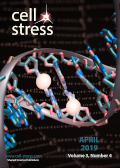Table of contents
Volume 3, Issue 4, pp. 110 - 138, April 2019
Mitochondria organize the cellular proteostatic response and promote cellular senescence
Yanjun Li, Lei Liu, Yushan Zhu and Quan Chen
News and thoughts |
page 110-114 | 10.15698/cst2019.04.181 | Full text | PDF |
Abstract
Mitochondria have relatively independent protein quality control systems, including their own chaperones for protein folding and AAA proteases for protein degradation. Accumulating evidence has shown that cytosolic proteins and disease-causing misfolded proteins can be translocated into mitochondria and then impinge upon their function. It is important to understand the interplay between cellular proteostasis and mitochondria, as impaired proteostasis and mitochondrial dysfunction are causally linked with aging and age-related disorders. This review highlights our recent finding showing that the outer mitochondrial membrane protein FUNDC1, a previously reported mitophagy receptor, interacts with the chaperone protein HSC70 to mediate the mitochondrial translocation of cytosolic proteasomal substrates via the TOM/TIM complex into the mitochondrial matrix where they can be degraded by LONP1 protease. Excessive accumulation of unfolded proteins within mitochondria triggers the formation of Mitochondrion-Associated Protein Aggregates (MAPAs), which are subsequently autophagically degraded in a FUNDC1-dependent manner. We suggest that mitochondria actively organize the cellular proteostatic response and that the interaction between FUNDC1 and HSC70 may represent a new link between impaired proteostasis, mitochondrial dysfunction and cellular aging.
Mitochondrial stress delays tumorigenesis in a Li-Fraumeni syndrome mouse model
Matthew P. Donnelly, Jie Li and Paul M. Hwang
News and thoughts |
page 115-117 | 10.15698/cst2019.04.182 | Full text | PDF |
Constitutional Mosaic Epimutations – a hidden cause of cancer?
Per E. Lønning, Hans P. Eikesdal, Inger M. Løes and Stian Knappskog
Reviews |
page 118-135 | 10.15698/cst2019.04.183 | Full text | PDF |
Abstract
Silencing of tumor suppressor genes by promoter hypermethylation is a key mechanism to facilitate cancer progression in many malignancies. While promoter hypermethylation can occur at later stages of the carcinogenesis process, constitutional methylation of key tumor suppressors may be an initiating event whereby cancer is started. Constitutional BRCA1 methylation due to cis-acting germline genetic variants is associated with a high risk of breast and ovarian cancer. However, this seems to be a rare event, restricted to a very limited number of families. In contrast, mosaic constitutional BRCA1 methylation is detected in 4-7% of newborn females without germline BRCA1 mutations. While the cause of such methylation is poorly understood, mosaic normal tissue BRCA1 methylation is associated with a 2-3 fold increased risk of high-grade serous ovarian cancer (HGSOC). As such, BRCA1 methylation may be the cause of a significant number of ovarian cancers. Given the molecular similarities between HGSOC and basal-like breast cancer, the findings with respect to HGSOC suggest that constitutional BRCA1 methylation could be a risk factor for basal-like breast cancer as well. Similar to BRCA1, some specific germline variants in MLH1 and MSH2 are associated with promoter methylation and a high risk of colorectal cancers in rare hereditary cases of the disease. However, as many as 15% of all colorectal cancers are of the microsatellite instability (MSI) “high” subtype, in which commonly the tumors harbor MLH1 hypermethylation. Constitutional mosaic methylation of MLH1 in normal tissues has been detected but not formally evaluated as a potential risk factor for incidental colorectal cancers. However, the findings with respect to BRCA1 in breast and ovarian cancer raises the question whether mosaic MLH1 methylation is a risk factor for MSI positive colorectal cancer as well. As for MGMT, a promoter variant is associated with elevated methylation across a panel of solid cancers, and MGMT promoter methylation may contribute to an elevated cancer risk in several of these malignancies. We hypothesize that constitutional mosaic promoter methylation of crucial tumor suppressors may trigger certain types of cancer, similar to germline mutations inactivating the same particular genes. Such constitutional methylation events may be a spark to ignite cancer development, and if associated with a significant cancer risk, screening for such epigenetic alterations could be part of cancer prevention programs to reduce cancer mortality in the future.
The role of keratins in modulating carcinogenesis via communication with cells of the immune system
Inês Sequeira and Fiona M. Watt
Microreviews |
page 136-138 | 10.15698/cst2019.04.184 | Full text | PDF |
Abstract
Keratins are intermediate filament proteins expressed by epithelial cells and provide mechanical support for diverse epithelia. In our recent study (Sequeira et al., Nat Comm 9(1):3437), we analysed the role of keratin 76 (Krt76) in inflammation and cancer. Krt76 is expressed throughout embryonic development in the differentiated epithelial layers of a subset of stratified epithelia including tongue, palate and stomach. It is significantly downregulated in human oral squamous cell carcinoma (OSCC), correlating strongly with poor prognosis. We have shown that Krt76-/- mice exhibit systemic inflammation with increased levels of circulating B cells, regulatory T cells and effector T cells. When mice are given a chemical carcinogen in the drinking water, tongue and gastric cancer formation is accelerated in Krt76-/- mutant mice. Our data suggest that the increased tumour susceptibility of Krt76-/- mice is in part due to the enhanced accumulation of regulatory T cells in the tumour microenvironment. Our results support the notion that keratins, in addition to their function as cytoskeletal components, regulate immunity and affect tumour susceptibility of epithelial cells.



